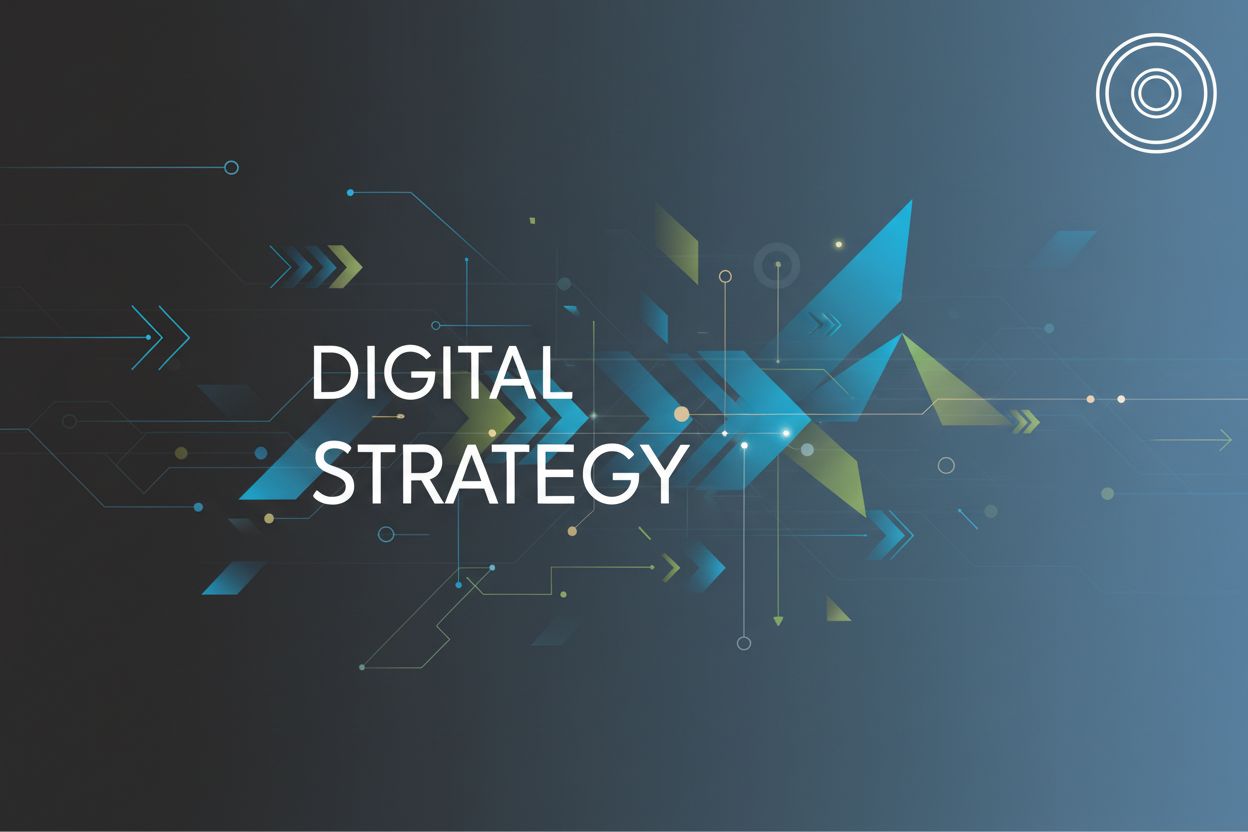Creating a Digital Marketing Strategy That Delivers Results
TL;DR
Why You Need a Digital Marketing Strategy That Actually Delivers
Okay, let's dive into why you really need a digital marketing strategy. I mean, sure, everyone's doing the digital thing, but are they actually getting anywhere? Probably not, and here's why you can't just wing it.
- Think of it this way: posting cat videos on TikTok isn't a strategy, it's just posting. A real strategy? It's about knowing why you're posting cat videos and how it ties back to your business goals. For example, if your objective is to increase brand awareness, your cat video strategy might involve creating a series of humorous, shareable clips that subtly feature your product or brand logo, aiming for viral reach and mentions across social platforms.
- A good strategy gives you purpose, direction, and makes everything work together. It's how you connect what you're doing to making real money or building a brand that people actually care about.
- And it’s not just about making money, it's about being consistent. Imagine a retail brand that's super edgy on Twitter but stuffy on their website? Confusing, right?
You know, the internet changes faster than I change my socks, and things are not static. A good strategy changes with it! As noted, an effective digital marketing strategy needs to evolve with shifting customer behaviors, technologies, and business goals.
It helps you move away from doing random stuff to actually getting results you can track and measure. Which, let's be honest, is the whole point.
Next up, we'll see how to adapt to change.
Step 1: Defining Clear Business Objectives
Alright, so you're staring at this blank page thinking, "Business objectives... where do I even start?" It's like trying to find your keys when you're already late – stressful, right? But trust me, it's easier than it looks.
- It all boils down to clarity. What do you actually want? Are we talking more eyeballs on your brand, getting folks to click that 'buy' button, or maybe just keeping the customers you already got happy?
- Think about it like this: where do you want to be in the next few months, next year, and even three years down the line? Jot it down, even if it sounds crazy ambitious right now.
- Ensure your digital marketing objectives are aligned with overall business goals and operational capabilities. For example, a successful social media campaign is ineffective if the sales team is not equipped to handle the resulting leads.
Let's say you're a small healthcare provider. A good objective might be, "Increase online appointment bookings by 30% in 6 months through targeted Google Ads focusing on keywords like 'urgent care near me' or specific medical services." Or, for a retail clothing brand, "Boost website sales by $100,000 next quarter by improving the mobile checkout experience."
Here's the deal: if you don't know where you’re going, you're gonna waste money. It's not just a cost; it's an investment, and you should get something back. Up next, we'll cover more concrete ways to make your objectives rock solid.
Step 2: Understand Your Audience Deeply
Okay, so you're not gonna hit a bullseye if you're shooting in the dark, right? Same goes for marketing. You gotta know who you're talkin' to.
Great marketing begins with the customer; it's important to understand who your audience is, what they care about, and how they behave online. But, like, really know them.
- Ditch the basic demographics: age, gender, location. Go deeper. What makes 'em tick? What keeps them up at night?
- Think psychographics: what are their values, aspirations? What kinda lifestyle they diggin'?
- Behavior is key: How they use the internet? What devices they glued to? What content do they eat up like candy?
- And, what’s their biggest pain point? What problem are they desperately trying to solve? For instance, if your audience is small business owners struggling with time management, their pain point might be feeling overwhelmed by administrative tasks. This understanding could inform content like "5 Time-Saving Hacks for Busy Entrepreneurs" or lead you to choose LinkedIn as a primary channel.
- Finally, what's that buying trigger? What finally makes 'em click "buy"?
To gather this info, you can use methods like customer surveys, in-depth interviews, analyzing website and social media analytics, and social listening tools to see what people are saying online.
Next up, let's put a face to the name – buyer personas!
Step 3: Audit Your Current Digital Position
Alright, so you've got this website, right? But like, is it actually doing its job? Time to find out!
- Website performance: Is it mobile-friendly? Gotta be, or you're losing folks. And speed? People bounce if it's slow.
- seo health: Audit elements like on-page optimization (meta descriptions, header tags), technical SEO (site speed, mobile-friendliness, crawlability), content relevance, and domain authority. Are you even showing up in searches?
- Analytics: Where's the traffic comin' from? And more importantly, where is your money going and is it being effective? Review key metrics such as Return on Ad Spend (ROAS), Cost Per Acquisition (CPA), and conversion rates for different channels to understand spending effectiveness.
- Competitor analysis: What are they doing that you're not? Seriously, take a peek, and make sure your not falling behind!
- Brand presence: Is your message consistent? 'Cause mixed signals is a big no-no.
Next, we'll talk about SWOT—and no, it's not a SWAT team.
Step 4: Choosing the Right Digital Channels
Okay, so you've got your objectives nailed down, right? Now, where do you actually spend your precious marketing dollars? Turns out, slapping your logo on every platform isn't exactly the secret sauce.
- It's all about alignment. Think of a healthcare provider aiming to boost appointments – they'd likely focus on seo to snag those "doctor near me" searches.
- Or, picture a hip clothing brand going wild on TikTok. Building brand buzz and showing off their threads to a Gen Z crowd.
- Don't forget the customer journey. A financial services firm might use email marketing to nurture leads with personalized advice, such as offering tailored investment tips based on a prospect's stated financial goals or providing a checklist for retirement planning based on their age bracket.
So, less is more, maybe? Pick the channels that'll help you reach the right people, with the right message, at the right time. Next, let's dive into how to actually create content your audience will love.
Step 5: Crafting a Compelling Content Plan
Alright, so you're creating content, but what kinda content? And how's it gonna reach eyeballs? That's where a content plan comes in, and its gotta be more than just blog posts, ya know?
- Educational blogs are great for answering customer questions and boosting your seo. Think about how-to guides, lists, and explainers.
- Whitepapers and guides can attract b2b leads with in-depth, valuable info. Perfect for showing you really know your stuff.
- Video content is king, really. Short clips for grabbing attention, longer ones for teaching.
- Case studies build trust by showing real results. Like, "We helped this company increase sales by this much."
Don't just publish and pray. Plan how content gets to the people! Your content plan should consider distribution channels:
- Owned media (your website, blog, email list) is ideal for in-depth content like educational blogs and whitepapers, allowing you full control over the message and user experience.
- Earned media (social shares, press mentions, reviews) can be amplified by creating highly shareable content like infographics or compelling video snippets that encourage organic reach.
- Paid media (social media ads, search ads, sponsored content) is effective for promoting content to a wider, targeted audience. For example, educational blogs are ideal for owned media (your website) and can be amplified through earned media (social shares) and paid media (promoted posts).
Having a content calendar keeps everything consistent. Next up: budgeting!
Step 6: Budget Allocation for Maximum Impact
Alright, so you got your content firing on all cylinders, but where's the cash gonna go? Turns out, a little planning goes a long way, and I mean a long way.
- Strategic spending is key: Nail those objectives and what the market's actually charging, ya know?
- Don't be spreadin' it too thin, either!
- For example, a good chunk goes to content (40%), then paid media (30%), seo (20%), and analytics (10%).
Please note: These percentages are illustrative and should be adjusted based on specific business goals, industry benchmarks, and the results of previous campaigns. Content is allocated a significant portion as it forms the foundation for engagement across all channels.
Budgets will vary by industry.
Next, let's get into marketing as an investment, not just some necessary evil.
Step 7: Implementation and A/B Testing
Okay, so you've got a plan, but now what? Time to put it into action—but not all at once!
- Think pilot campaigns first. Test the waters with a smaller audience before throwin' the whole budget at it.
- a/b testing is your friend, seriously. Ad copy, images, calls to action--tweak everything.
- Don't be afraid to try new channels, just keep an eye on the ROI. When testing new channels, focus on key performance indicators (KPIs) relevant to your objectives, such as cost per lead, conversion rate, and customer acquisition cost, to determine their effectiveness.
Next up, figuring out if any of this is actually working!
Step 8: Measurement, Analysis and Strategic Optimization
Alright, so you've been implementing and testing, but is it paying off? Time to see if you're just burning cash or making it rain!
- Website metrics are key: Track traffic, bounce rate, and time on page. For a retail brand, this shows if your site's engaging or a digital ghost town.
- Lead generation matters: What's the cost per lead? Are they good leads? A financial firm needs quality leads, not just tire-kickers.
- Revenue, baby: What sales can you tie back to your campaigns? That's the real ROI. Common attribution models like UTM parameters, CRM integration, or marketing attribution software can help track sales back to specific marketing efforts.
- Customer metrics count too: Are people sticking around? What's their lifetime value? Happy customers are repeat customers.
By analyzing these metrics, you can identify underperforming areas, reallocate budget to more effective channels, and refine your content and targeting strategies.
Onward! Time to optimize this whole thing.
Common Mistakes to Absolutely Avoid
So, you got your digital marketing strategy all set—but what if it's actually, well, kinda broken? Here's some common mistakes that are easy to make, and even easier to avoid.
- Overcomplicating things: Trying to do everything at once? Big mistake. Focus on a few key areas instead of spreadin' yourself too thin.
- Mobile? What's mobile?: Listen, if your website ain't mobile-friendly, you're losing customers. Period.
- Sales and marketing in separate silos: Get these teams talkin' to each other! If your sales team doesn't know what your marketing team's up to, leads are gonna slip through the cracks, and nobody wants that. Implement regular cross-functional meetings, shared CRM data, and joint goal-setting to foster better communication.
Next up—how to keep your strategy from crumbling!
Future-Proofing Your Digital Strategy
Alright, future-proofing? It's not just about guessing what's next; it's about building a strategy that can roll with the punches. Think of it as less crystal ball, more a really sturdy umbrella.
- Adopt ai-powered tools: Seriously, get on it. Whether it's for automating tasks or diving deep into analytics, ai is a game-changer. Examples include AI-driven content optimization tools that suggest improvements for blog posts, predictive analytics platforms that forecast customer churn, or AI-powered ad targeting that refines audience segmentation in real-time.
- Build first-party data: Cookies are crumbling, so owning your data is more critical than ever. Think loyalty programs, direct sign-ups, anything to get that sweet, sweet data directly from your customers.
- Prioritize video and interactive content: People are visual creatures, and ain't no one got time for walls of text. Short, engaging vids and interactive experiences are where it's at.
Data and ethics? That's the new tightrope walk. Transparency is key, so be upfront about how you're using data and give users control. This can involve clear privacy policies, easy opt-out mechanisms for marketing communications, and providing users with access to their data. Up next, let's wrap this up and talk about some final thoughts and keeping it real.
Final Thoughts: Strategic Growth
Alright, so you've made it this far! You've put in the work, and now its time to reap the rewards. But don't just sit back and admire your handiwork… keep goin'!
- Lead Generation: Digital marketing isn't just about pretty pictures; it's about bringin' in those leads, ya know? It's about turning clicks into customers and website visits into real-world sales.
- Brand Building: You're not just sellin' stuff; you're buildin' a brand that people actually trust. That trust? That's gold in the long run.
- Trust and Credibility: In a world full of noise, being seen as a credible source is a game-changer.
Don't just see marketing as a cost—see it as an investment. It's what keeps you growin', even when things get tough. So, keep at it! Embracing continuous learning, adapting to market shifts, and iterating on your strategies are the keys to sustained growth in the dynamic world of digital marketing.




